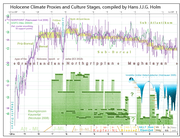-
Combination of temperature indicators ("proxies") for north-western Europe from Greenland icecores and Alpine glacier extensions, with subdivisions from three disciplines
-
Paleogeographic reconstruction of the North Sea approximately 9,000 years ago during the early Holocene and after the end of the Last Glacial Period
-
Bronze bead necklace, Muséum de Toulouse
Climate

The climate throughout the Holocene has shown significant variability despite ice core records from Greenland suggesting a more stable climate following the preceding ice age. Marine chemical fluxes during the Holocene were lower than during the Younger Dryas, but were still considerable enough to imply notable changes in the climate.
The temporal and spatial extent of climate change during the Holocene is an area of considerable uncertainty, with radiative forcing recently proposed to be the origin of cycles identified in the North Atlantic region. Climate cyclicity through the Holocene (Bond events) has been observed in or near marine settings and is strongly controlled by glacial input to the North Atlantic.[25][26] Periodicities of ≈2500, ≈1500, and ≈1000 years are generally observed in the North Atlantic.[27][28][29] At the same time spectral analyses of the continental record, which is remote from oceanic influence, reveal persistent periodicities of 1,000 and 500 years that may correspond to solar activity variations during the Holocene Epoch.[30] A 1,500-year cycle corresponding to the North Atlantic oceanic circulation may have had widespread global distribution in the Late Holocene.[30] From 8,500 BP to 6,700 BP, North Atlantic climate oscillations were highly irregular and erratic because of perturbations from substantial ice discharge into the ocean from the collapsing Laurentide Ice Sheet.[31] The Greenland ice core records indicate that climate changes became more regional and had a larger effect on the mid-to-low latitudes and mid-to-high latitudes after ~5600 B.P.[32]
Human activity through land use changes was an important influence on Holocene climatic changes, and is believed to be why the Holocene is an atypical interglacial that has not experienced significant cooling over its course.[33] From the start of the Industrial Revolution onwards, large-scale anthropogenic greenhouse gas emissions caused the Earth to warm.[34] Likewise, climatic changes have induced substantial changes in human civilisation over the course of the Holocene.[35][36]
During the transition from the last glacial to the Holocene, the Huelmo–Mascardi Cold Reversal in the Southern Hemisphere began before the Younger Dryas, and the maximum warmth flowed south to north from 11,000 to 7,000 years ago. It appears that this was influenced by the residual glacial ice remaining in the Northern Hemisphere until the later date.[citation needed] The first major phase of Holocene climate was the Preboreal.[37] At the start of the Preboreal occurred the Preboreal Oscillation (PBO).[38] The Holocene Climatic Optimum (HCO) was a period of warming throughout the globe but was not globally synchronous and uniform.[39] Following the HCO, the global climate entered a broad trend of very gradual cooling known as Neoglaciation, which lasted from the end of the HCO to before the Industrial Revolution.[37] From the 10th-14th century, the climate was similar to that of modern times during a period known as the Mediaeval Warm Period (MWP), also known as the Mediaeval Climatic Optimum (MCO). It was found that the warming that is taking place in current years is both more frequent and more spatially homogeneous than what was experienced during the MWP. A warming of +1 degree Celsius occurs 5–40 times more frequently in modern years than during the MWP. The major forcing during the MWP was due to greater solar activity, which led to heterogeneity compared to the greenhouse gas forcing of modern years that leads to more homogeneous warming. This was followed by the Little Ice Age (LIA) from the 13th or 14th century to the mid-19th century.[40] The LIA was the coldest interval of time of the past two millennia.[41] Following the Industrial Revolution, warm decadal intervals became more common relative to before as a consequence of anthropogenic greenhouse gases, resulting in progressive global warming.[34] In the late 20th century, anthropogenic forcing superseded solar activity as the dominant driver of climate change,[42] though solar activity has continued to play a role.[43][44]
Europe
Drangajökull, Iceland's northernmost glacier, melted shortly after 9,200 BP.[45] In Northern Germany, the Middle Holocene saw a drastic increase in the amount of raised bogs, most likely related to sea level rise. Although human activity affected geomorphology and landscape evolution in Northern Germany throughout the Holocene, it only became a dominant influence in the last four centuries.[46] In the French Alps, geochemistry and lithium isotope signatures in lake sediments have suggested gradual soil formation from the Last Glacial Period to the Holocene climatic optimum, and this soil development was altered by the settlement of human societies. Early anthropogenic activities such as deforestation and agriculture reinforced soil erosion, which peaked in the Middle Ages at an unprecedented level, marking human forcing as the most powerful factor affecting surface processes.[47]
Africa
North Africa, dominated by the Sahara Desert in the present, was instead a savanna dotted with large lakes during the Early and Middle Holocene,[48] regionally known as the African Humid Period (AHP).[49] The northward migration of the Intertropical Convergence Zone (ITCZ) produced increased monsoon rainfall over North Africa.[50] The lush vegetation of the Sahara brought an increase in pastoralism.[51] The AHP ended around 5,500 BP, after which the Sahara began to dry and become the desert it is today.[52]
A stronger East African Monsoon during the Middle Holocene increased precipitation in East Africa and raised lake levels.[53] Around 800 AD, or 1,150 BP, a marine transgression occurred in southeastern Africa; in the Lake Lungué basin, this sea level highstand occurred from 740 to 910 AD, or from 1,210 to 1,040 BP, as evidenced by the lake's connection to the Indian Ocean at this time. This transgression was followed by a period of transition that lasted until 590 BP, when the region experienced significant aridification and began to be extensively used by humans for livestock herding.[54]
In the Kalahari Desert, Holocene climate was overall very stable and environmental change was of low amplitude. Relatively cool conditions have prevailed since 4,000 BP.[55]
Middle East
During the Late Holocene, the coastline of the Levant receded westward, prompting a shift in human settlement patterns following this marine regression.[56]
Central Asia
In Xinjiang, long-term Holocene warming increased meltwater supply during summers, creating large lakes and oases at low altitudes and inducing enhanced moisture recycling.[57] In the Tien Shan, sedimentological evidence from Swan Lake suggests the period between 8,500 and 6,900 BP was relatively warm, with steppe meadow vegetation being predominant. An increase in Cyperaceae from 6,900 to 2,600 BP indicates cooling and humidification of the Tian Shan climate that was interrupted by a warm period between 5,500 and 4,500 BP. After 2,600 BP, an alpine steppe climate prevailed across the region.[58] Sand dune evolution in the Bayanbulak Basin shows that the region was very dry from the Holocene's beginning until around 6,500 BP, when a wet interval began.[59] In the Tibetan Plateau, the moisture optimum spanned from around 7,500 to 5,500 BP.[60]
South Asia
After 11,800 BP, and especially between 10,800 and 9,200 BP, Ladakh experienced tremendous moisture increase most likely related to the strengthening of the Indian Summer Monsoon (ISM). From 9,200 to 6,900 BP, relative aridity persisted in Ladakh. A second major humid phase occurred in Ladakh from 6,900 to 4,800 BP, after which the region was again arid.[61]
From 900 to 1,200 AD, during the MWP, the ISM was again strong as evidenced by low δ18O values from the Ganga Plain.[62]
The sediments of Lonar Lake in Maharashtra record dry conditions around 11,400 BP that transitioned into a much wetter climate from 11,400 to 11,100 BP due to intensification of the ISM. Over the Early Holocene, the region was very wet, but during the Middle Holocene from 6,200 to 3,900 BP, aridification occurred, with the subsequent Late Holocene being relatively arid as a whole.[63]
Coastal southwestern India experienced a stronger ISM from 9,690 to 7,560 BP, during the HCO. From 3,510 to 2,550 BP, during the Late Holocene, the ISM became weaker, although this weakening was interrupted by an interval of unusually high ISM strength from 3,400 to 3,200 BP.[64]
East Asia
Southwestern China experienced long-term warming during the Early Holocene up until ~7,000 BP.[65] Northern China experienced an abrupt aridification event approximately 4,000 BP.[66] From around 3,500 to 3,000 BP, northeastern China underwent a prolonged cooling, manifesting itself with the disruption of Bronze Age civilisations in the region.[67] Eastern and southern China, the monsoonal regions of China, were wetter than present in the Early and Middle Holocene.[68] Lake Huguangyan's TOC, δ13Cwax, δ13Corg, δ15N values suggest the period of peak moisture lasted from 9,200 to 1,800 BP and was attributable to a strong East Asian Summer Monsoon (EASM).[69] Late Holocene cooling events in the region were dominantly influenced by solar forcing, with many individual cold snaps linked to solar minima such as the Oort, Wolf, Spörer, and Maunder Minima.[70] Monsoonal regions of China became more arid in the Late Holocene.[68]
Southeast Asia
Before 7,500 BP, the Gulf of Thailand was exposed above sea level and was very arid. A marine transgression occurred from 7,500 to 6,200 BP amidst global warming.[71]
North America
During the Middle Holocene, western North America was drier than present, with wetter winters and drier summers.[72] After the end of the thermal maximum of the HCO around 4,500 BP, the East Greenland Current underwent strengthening.[73] A massive megadrought occurred from 2,800 to 1,850 BP in the Great Basin.[74]
Eastern North America underwent abrupt warming and humidification around 10,500 BP and then declined from 9,300 to 9,100 BP. The region has undergone a long term wettening since 5,500 BP occasionally interrupted by intervals of high aridity. A major cool event lasting from 5,500 to 4,700 BP was coeval with a major humidification before being terminated by a major drought and warming at the end of that interval.[75]
South America
During the Early Holocene, relative sea level rose in the Bahia region, causing a landward expansion of mangroves. During the Late Holocene, the mangroves declined as sea level dropped and freshwater supply increased.[76] In the Santa Catarina region, the maximum sea level highstand was around 2.1 metres above present and occurred about 5,800 to 5,000 BP.[77] Sea levels at Rocas Atoll were likewise higher than present for much of the Late Holocene.[78]
Australia
The Northwest Australian Summer Monsoon was in a strong phase from 8,500 to 6,400 BP, from 5,000 to 4,000 BP (possibly until 3,000 BP), and from 1,300 to 900 BP, with weak phases in between and the current weak phase beginning around 900 BP after the end of the last strong phase.[79]
New Zealand
Ice core measurements imply that the sea surface temperature (SST) gradient east of New Zealand, across the subtropical front (STF), was around 2 degrees Celsius during the HCO. This temperature gradient is significantly less than modern times, which is around 6 degrees Celsius. A study utilizing five SST proxies from 37°S to 60°S latitude confirmed that the strong temperature gradient was confined to the area immediately south of the STF, and is correlated with reduced westerly winds near New Zealand.[80] Since 7,100 BP, New Zealand experienced 53 cyclones similar in magnitude to Cyclone Bola.[81]
Pacific
Evidence from the Galápagos Islands shows that the El Niño–Southern Oscillation (ENSO) was significantly weaker during the Middle Holocene, but that the strength of ENSO became moderate to high over the Late Holocene.[82]




